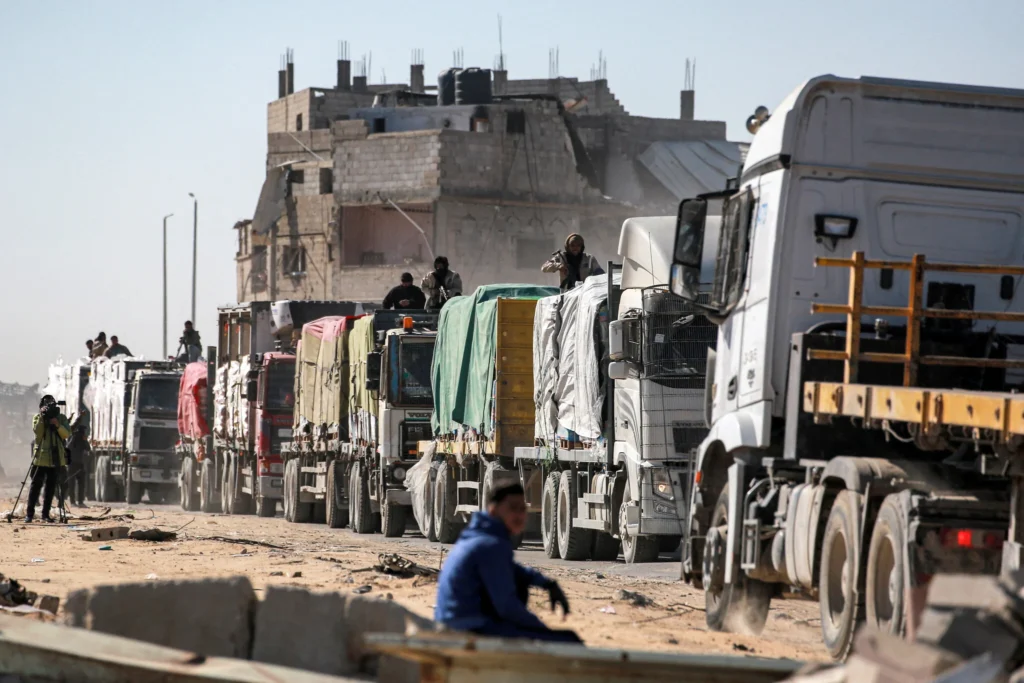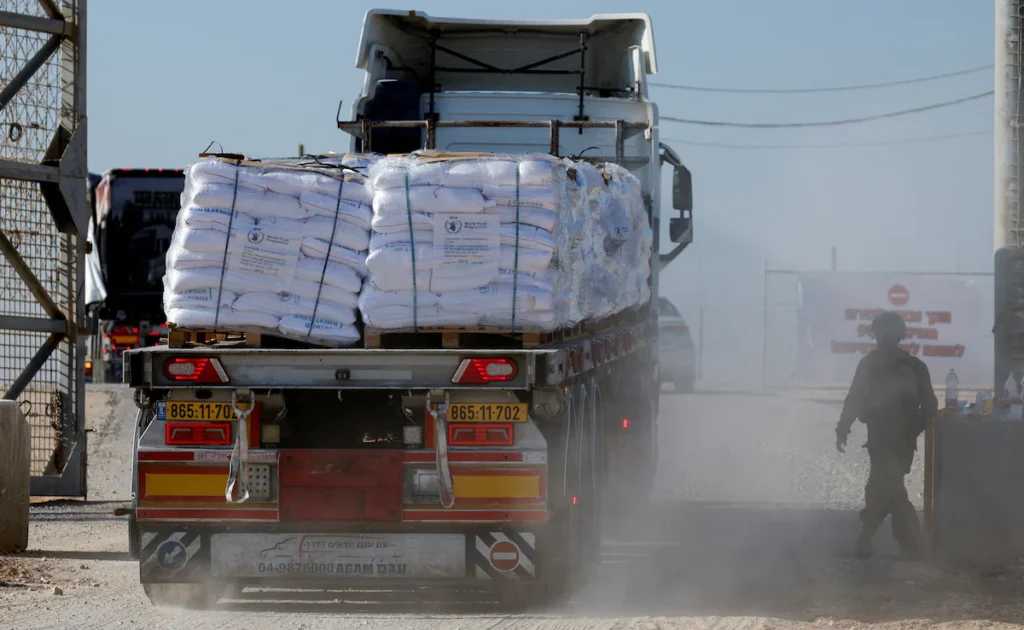UAE aid trucks looted in Gaza are now at the center of a growing humanitarian disaster. These trucks were meant to deliver food and supplies to struggling civilians. Instead, they were attacked and stripped of their goods in an area where Israeli forces are in control.
Out of 24 trucks sent to Gaza by the UAE, only one reached its destination. The others were taken over and emptied before they could complete their journey. The mission’s leaders expressed frustration, calling the situation unacceptable.
A Mission of Hope Turned into Loss
The UAE has sent aid to Gaza as part of its mission to help families who have been suffering due to the ongoing conflict. The trucks carried vital supplies such as flour, oil, cooking gas, salt, and sugar. These items are badly needed in Gaza, where many people are going without basic necessities.

But this recent mission ended in loss. The UAE called out the looting as a serious attack on the humanitarian rights of innocent people. They also pointed out that the incident happened in an area under Israeli military control.
Unsafe Crossing Routes Put Convoys at Risk
The UAE’s humanitarian mission blamed the route assigned for the trucks. According to their statement, Israeli authorities insisted on using a road they had warned was unsafe. Despite those warnings, the trucks were made to pass through that area.
Without protection and in a high-risk zone, the aid trucks became targets. The convoy was left vulnerable to theft and violence, putting both supplies and drivers at risk.
Aid Shortage Is Pushing Gaza into Hunger
The looting of UAE aid trucks is just one example of a wider issue in Gaza. Food, clean water, and other basic goods are scarce. Many people are relying entirely on aid to survive. When trucks like these are attacked, thousands are left without food for days.
In some areas, people are lining up for hours for just a small bag of flour or a bottle of cooking oil. Others are unable to find anything to eat at all. The humanitarian crisis is worsening with each day that aid is delayed or stolen.
Lawlessness Grows as Desperation Rises
Due to ongoing fighting and the breakdown of public order, looting has become common in Gaza. Armed groups are taking advantage of the chaos. In many cases, they are attacking aid convoys and taking supplies by force.
There is little protection for drivers or trucks once they cross into Gaza. With no working police force and limited local security, aid missions are now operating under extreme danger.
Gaza Civilians Paying the Price

The people paying the highest price are innocent civilians. Families that had been waiting for UAE aid have now been left empty-handed. Mothers are struggling to feed their children. Elderly people are going without medication. People with disabilities or health problems are most at risk.
The loss of this aid has caused anger and sadness across Gaza. For many, this was a rare chance to get food and support. Now, they face more days of hunger and fear.
The UAE Condemns Looting, Demands Accountability
Leaders of the UAE humanitarian mission strongly condemned the looting. They said it was a direct violation of international humanitarian law. They also demanded better protection for aid convoys in the future.
They added that the looting was a result of unsafe crossing routes forced by the Israeli army. They called on all parties involved in the conflict to make sure that aid trucks can move freely and safely.
The UAE is committed to helping the people of Gaza. But without guarantees of security, future missions may be harder to carry out.
Global Outcry Over Aid Disruption
The international community is also speaking up. Humanitarian organizations, aid groups, and foreign governments are calling for urgent solutions. Many are urging stronger coordination and protection for humanitarian workers.
There is also growing concern that Gaza could fall deeper into a hunger emergency if aid continues to be blocked or stolen. With the situation already fragile, each failed delivery pushes the region closer to collapse.
The Role of Israeli Forces Under Scrutiny
As the looting happened in an area under Israeli control, questions are being raised. Critics want to know how the trucks were attacked without any intervention. They are also asking why such a risky route was chosen, despite clear warnings.
Some believe this reflects a lack of concern for the safety of aid workers and the people of Gaza. Others say it’s part of a larger pattern of restricting humanitarian efforts.
No End in Sight for Gaza’s Humanitarian Suffering
Sadly, this incident is not a one-time event. Other aid trucks, including those from international groups, have also been attacked. Many drivers now fear for their lives when entering Gaza.
Without stronger safety measures and better planning, the cycle of violence and aid loss may continue. That could leave even more people without food, water, or medicine in the weeks ahead.
What Needs to Change

To fix the current crisis, several key steps are needed:
- Safe and clearly marked routes for aid convoys must be established.
- Security guarantees from all parties in the conflict should be agreed upon.
- Fast, unhindered entry for food and supplies must be allowed.
- Criminal groups targeting humanitarian aid must be held accountable.
- A united international response should support aid delivery and protect civilians.
These changes could save lives and restore hope for many suffering families.
Conclusion: Lives Depend on Action, Not Promises
The looting of UAE aid trucks in Gaza has shocked and saddened many around the world. It has shown how dangerous and unpredictable the situation has become for those trying to help. At the same time, it has revealed just how much the people of Gaza depend on that help.
Without fast action, the humanitarian crisis will grow worse. The world must respond — not just with statements, but with real protection and support for those risking their lives to bring aid to the most vulnerable.
Let this moment be a call for urgency, humanity, and accountability.
Read More: AI in Saudi Arabia: Driving $135bn Economic Growth













